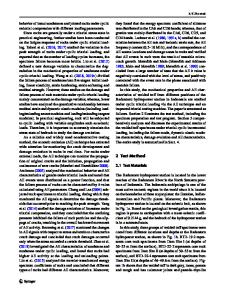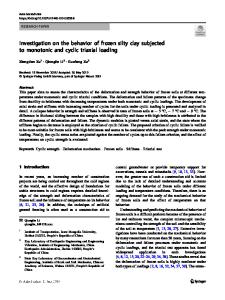Experimental Study on Rock Strength and Deformation Characteristics Under Triaxial Cyclic Loading and Unloading Conditio
- PDF / 2,798,596 Bytes
- 21 Pages / 595.276 x 790.866 pts Page_size
- 54 Downloads / 400 Views
ORIGINAL PAPER
Experimental Study on Rock Strength and Deformation Characteristics Under Triaxial Cyclic Loading and Unloading Conditions Qing‑bin Meng1,2 · Jiang‑Feng Liu1,2 · Li Ren2 · Hai Pu1,3 · Yan‑long Chen1 Received: 24 May 2020 / Accepted: 21 October 2020 © Springer-Verlag GmbH Austria, part of Springer Nature 2020
Abstract The mechanical behavior of rock under cyclic loading is quite complicated compared to monotonic loading or unloading conditions. The triaxial cyclic loading and unloading testing of rock specimens under 6 confining pressures (σ3) was carried out through the MTS 815 rock mechanics testing system, to explore the strength, deformation, and expansion characteristics of the rock specimens. The stress–strain curves of the rock specimens in the triaxial cyclic loading and unloading testing presented the hysteresis effect. Besides, as σ3 increased, the rock specimen strength increased, while the failure form brittle to ductile. The elasticity modulus (El) increased first and consequently decreased as the cycle index increased, while it increased as σ3 increased. However, the generalized Poisson’s ratio (μl) increased as the cycle index increased, whereas it decreased as the σ3 increased. Based on the Mohr–Coulomb strength criterion and plastic shear strain (γp) as the plastic parameter, the subsequent yield plane model of the loaded rock was characterized by generalized cohesion (c´) and generalized internal friction angle (φ´). Ultimately, the evolution rules of c´, φ´ and Ψ (dilatancy angle), with σ3 and γp were revealed. Moreover, the post-peak dilatancy angle models with regard to the influence of σ3 and γp on the volume dilatancy of the rock specimen were established, which indicated that Ψ increased first and consequently decreased along with the γp increase, whereas it decreased as the σ3 increased. Keywords Rock mechanics · Triaxial cyclic loading and unloading testing · Strength and deformation characteristics · Dilatancy · Dilatancy angle model
1 Introduction The deformation and failure rules of rocks as natural geological materials are closely related to the construction safety and service life of rock engineering and the occurrence of disasters. The strength and deformation characteristics of rock are the basis for rock engineering stability analysis and * Jiang‑Feng Liu [email protected] * Li Ren renli‑[email protected] 1
State Key Laboratory for Geomechanics and Deep Underground Engineering, China University of Mining and Technology, Xuzhou 221116, China
2
Key Laboratory of Deep Earth Science and Engineering, Sichuan University, Ministry of Education, Chengdu 610065, China
3
College of Mining Engineering and Geology, Xinjiang Institute of Engineering, Urumqi 830091, China
reinforcement design (Baud et al. 2000; Tavallali and Vervoort 2010; Amann et al. 2011; Yang et al. 2019). A certain time interval of the construction or process exists during the construction of roadways (caverns and tunnels), periodic reservoir water storage and reservoir discharge, excavati
Data Loading...











